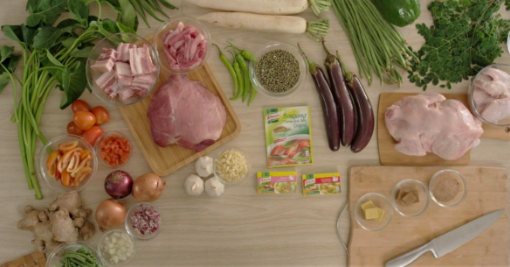While the road to survival involves eating our way out to fight starvation, many of the foods we fill our stomachs with or dispose as waste, may have a bigger impact on our planet than many of us realize.
The process of producing food to meet the demands of an arguably overpopulated planet has been contributing to the problem of climate change. The way food is being grown and produced globally is damaging soil, polluting the air and causing deforestation. At the same time, the extreme effects of climate change are putting our food at risk all over the world.
These current practices of producing and consuming food are not sustainable in the long term and the next generation may suffer its consequences. According to the UN Food and Agriculture Organization the world may have fewer than 60 harvests left if current rates of degradation continue.
Knorr, one of the world’s largest food brands, have joined forces with experts in food sustainability, agriculture and nutrition to identify and shortlist The Future 50 Foods. It was written by Knorr, together with leading conservation organisation WWF-UK, and Dr. Adam Drewnowski, Director of The Center of Public Health Nutrition at the University of Washington, with the ambition to empower positive change.
The report provides a tangible solution to keep the growing population healthy, and reduce the negative impact our food has on the environment. It identifies 50 plant-based, future-facing foods that we should eat more of for our health and the health of the planet.
It also follows the pivotal Food in the Anthropocene: the EAT–Lancet Commission on healthy diets from sustainable food systems released in January 2019 and WWF’s Living Planet Report released in October 2018, which highlight the changes we need to make to our global food system and the significant overlap between an environmentally sustainable diet and a healthy diet.
The 50 foods are a combination of familiar, although under-consumed foods, with less globally well-known foods like moringa (malunggay), mung beans (monggo), and white icicle radish (labanos). Each has been selected based on its nutritional value, relative environmental impact, flavour, acceptability and potential accessibility and affordability. Some have higher yields than similar foods and several are tolerant of challenging weather and environmental conditions, meaning they could be invaluable in the face of growing climate uncertainty. Each has a story to tell.
“Seventy-five percent of what the world eats comes from just twelve crops and five animal species, which has serious implications for both the health of our rapidly growing population and the health of our planet. Unless we change the foods we eat and the way we grow them, it will be challenging to have enough food to feed us all well. Our ambition is to make it easy for people to eat a wider variety of foods that are good for us and good for the planet, and, of course, delicious at the same time,” says April Redmond, Global Vice President of Knorr.
In the Philippines alone, there are at least seven million malnourished children, according to a report by the Food and Nutrition Research Institute (FNRI). The two main drivers of malnutrition prevalence are: lack of education on proper nutrition, and limited budget to prepare nutritious meals. As a result, lower-income families resort to cheaper food alternatives that are more often than not, high in salt or sugar, unaware of the nutritional deficiencies, namely underweight and stunting, these cause their children.
This highlights the gap in addressing this problem: the need for Filipino families to learn proper nutrition in their own homes.
The Future 50 Foods report notes three key changes for healthier global population and a healthier planet:
1. Greater variety and a larger amount of vegetables
2. More plant-based sources of protein in place of meat, poultry, dairy, and fish
3. More variety in the types of grains, cereals and other sources of carbohydrates
The Future 50 Foods report is designed to inspire and facilitate these shifts by celebrating the wide variety of foods available.

Some of our well-loved Filipino meals use Future 50 ingredients that are healthy for us and good for the planet.
“We are happy to announce that out of the Future 50 global ingredients, eight are found in the Philippines and are already incorporated in Knorr’s top dishes like tinola, ginisang monggo, and sinigang,” said Kristine Go, Foods Marketing Director of Unilever Philippines.
The full list of Future 50 Foods ingredients:
The eight local ingredients are moringa (malunggay), okra, white icicle radish (labanos), purple yam (ube), Chinese cabbage (bok-choi), soybean (tokwa), mung bean (monggo), and bean sprouts (toge).
Knorr Philippines recognizes that it plays a key role in shaping food consumption habits that are good for the Filipinos and for the environment. Recipe books under the Knorr Lutong Nanay Nutri-Program are designed to aid mothers as they introduce healthy and sustainable choices for their families through nutritious, delicious, and affordable home-cooked meals. Participants have access to a supplemental feeding program and nutrition education modules in partnership with the government and NGOs.
“Since 2002, the program has made an impact on the lives of 1.5 million Filipino children who were previously undernourished. The Future 50 Foods Report provides us with a clear path on how we can continue to empower communities to improve their health, while ensuring the sustainability of our food resources,” Unilever Philippines Chairman Benjie Yap said.
The Future 50 Foods Report provides a clear path on how we can continue to empower communities to improve their health, while ensuring the sustainability of our food resources.
For more information about the Knorr Lutong Nanay Nutri-Program, visit www.knorr.com/ph/Lutong-Nanay.html.
ADVT.

